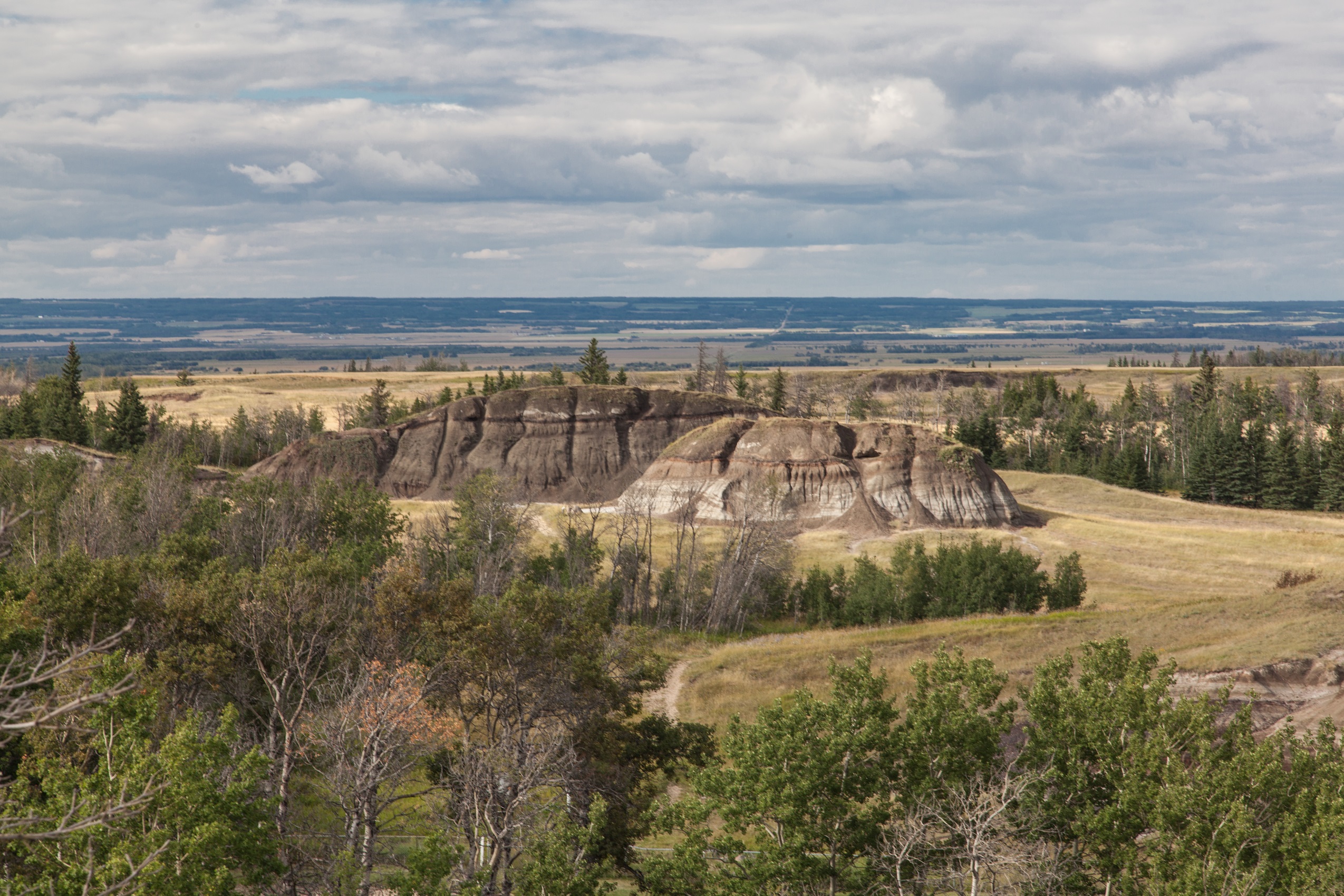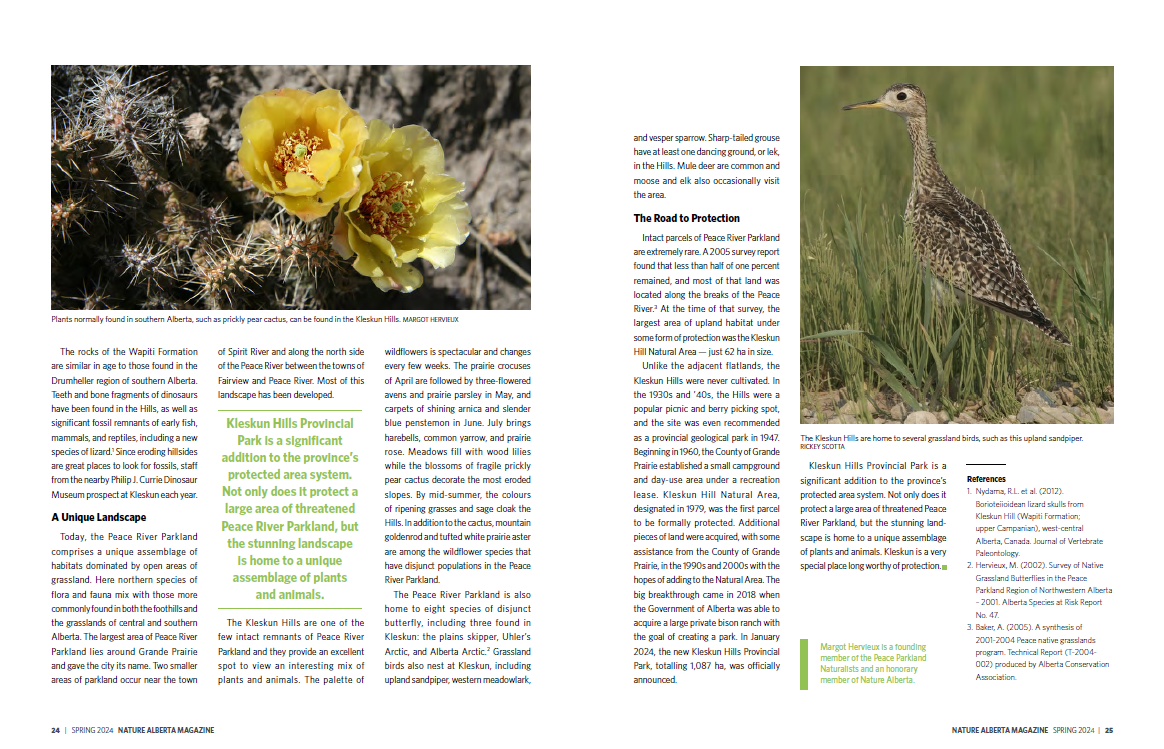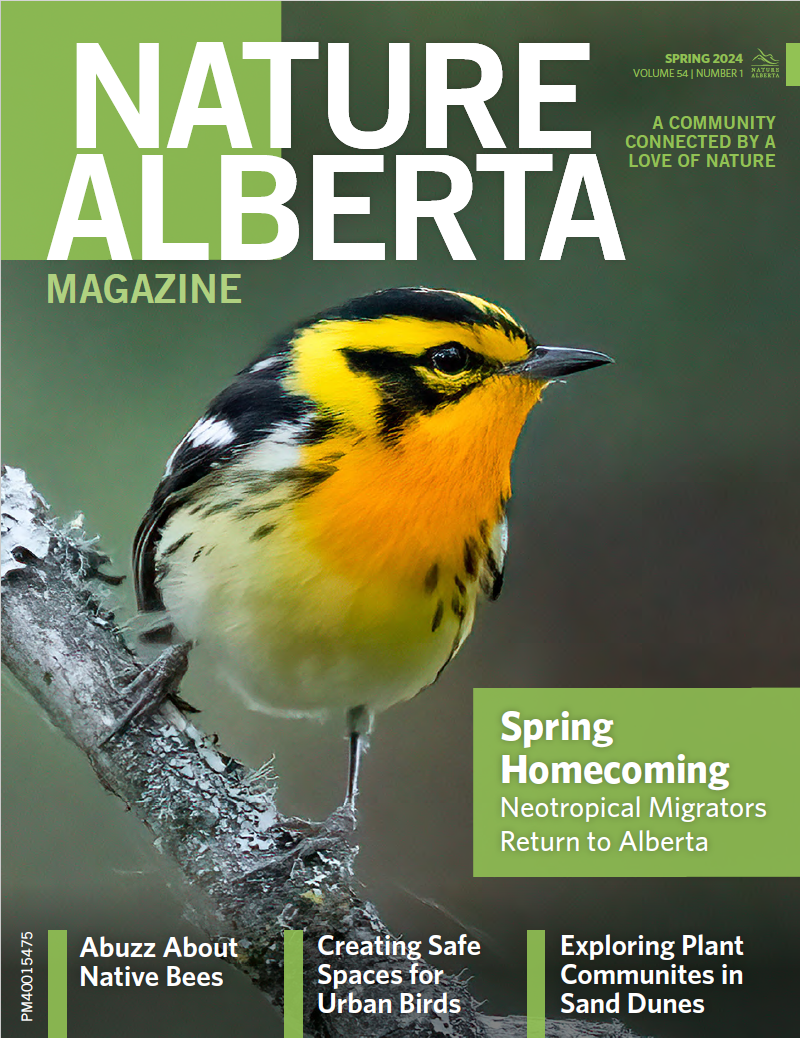The Kleskun Hills: Alberta’s Newest Provincial Park
22 April 2024

BY MARGOT HERVIEUX
Rising out of the farmland east of Grande Prairie is a height of land called the Kleskun Hills. The Hills contain the largest remaining tract of upland Peace River Parkland, a natural subregion found only in northwestern Alberta. This mosaic of native grasslands, aspen woods, eroded badlands, ponds, and tame pasture has now been officially designated as Kleskun Hills Provincial Park.
Ever since the area was resettled after the last Ice Age, the Kleskun Hills have been important to the local people. The Beaver and later the Cree First Nations hunted and collected berries and herbs in and around the Hills. When the first wave of European homesteaders arrived on the Edson Trail in 1911, their wagons skirted the Hills, leaving ruts that are still visible in the Park.
Geological History
The geologic history of the Kleskun Hills is told in the eroded badland formations along the eastern end of the Hills. These deeply eroded gullies and slopes expose layers of rock laid down over millions of years. Alternating layers of sand, clay, decaying plants from ancient river deltas, and volcanic ash were compressed over time to become the sandstone, shale, coal, and bentonite clay of the Wapiti Formation.
At the end of the last Ice Age, over 11,000 years ago, glacial Lake Peace flooded much of the current Peace River basin, including the land around the Kleskun Hills. When ice dams forming the lake broke, vast amounts of rushing water carved off the hills and started the erosion process that shapes them to this day.
The rocks of the Wapiti Formation are similar in age to those found in the Drumheller region of southern Alberta. Teeth and bone fragments of dinosaurs have been found in the Hills, as well as significant fossil remnants of early fish, mammals, and reptiles, including a new species of lizard.1 Since eroding hillsides are great places to look for fossils, staff from the nearby Philip J. Currie Dinosaur Museum prospect at Kleskun each year.
A Unique Landscape
Today, the Peace River Parkland comprises a unique assemblage of habitats dominated by open areas of grassland. Here northern species of flora and fauna mix with those more commonly found in both the foothills and the grasslands of central and southern Alberta. The largest area of Peace River Parkland lies around Grande Prairie and gave the city its name. Two smaller areas of parkland occur near the town of Spirit River and along the north side of the Peace River between the towns of Fairview and Peace River. Most of this landscape has been developed.
The Kleskun Hills are one of the few intact remnants of Peace River Parkland and they provide an excellent spot to view an interesting mix of plants and animals. The palette of wildflowers is spectacular and changes every few weeks. The prairie crocuses of April are followed by three-flowered avens and prairie parsley in May, and carpets of shining arnica and slender blue penstemon in June. July brings harebells, common yarrow, and prairie rose. Meadows fill with wood lilies while the blossoms of fragile prickly pear cactus decorate the most eroded slopes. By mid-summer, the colours of ripening grasses and sage cloak the Hills. In addition to the cactus, mountain goldenrod and tufted white prairie aster are among the wildflower species that have disjunct populations in the Peace River Parkland.
The Peace River Parkland is also home to eight species of disjunct butterfly, including three found in Kleskun: the plains skipper, Uhler’s Arctic, and Alberta Arctic.2 Grassland birds also nest at Kleskun, including upland sandpiper, western meadowlark, and vesper sparrow. Sharp-tailed grouse have at least one dancing ground, or lek, in the Hills. Mule deer are common and moose and elk also occasionally visit the area.
The Road to Protection
Intact parcels of Peace River Parkland are extremely rare. A 2005 survey report found that less than half of one percent remained, and most of that land was located along the breaks of the Peace River.3 At the time of that survey, the largest area of upland habitat under some form of protection was the Kleskun Hill Natural Area — just 62 ha in size.
Unlike the adjacent flatlands, the Kleskun Hills were never cultivated. In the 1930s and ’40s, the Hills were a popular picnic and berry picking spot, and the site was even recommended as a provincial geological park in 1947. Beginning in 1960, the County of Grande Prairie established a small campground and day-use area under a recreation lease. Kleskun Hill Natural Area, designated in 1979, was the first parcel to be formally protected. Additional pieces of land were acquired, with some assistance from the County of Grande Prairie, in the 1990s and 2000s with the hopes of adding to the Natural Area. The big breakthrough came in 2018 when the Government of Alberta was able to acquire a large private bison ranch with the goal of creating a park. In January 2024, the new Kleskun Hills Provincial Park, totalling 1,087 ha, was officially announced.
Kleskun Hills Provincial Park is a significant addition to the province’s protected area system. Not only does it protect a large area of threatened Peace River Parkland, but the stunning landscape is home to a unique assemblage of plants and animals. Kleskun is a very special place long worthy of protection.
Margot Hervieux is a founding member of the Peace Parkland Naturalists and an honorary member of Nature Alberta.
Read the Original Article for this Post
For a richer reading experience, view this article in the professionally designed online magazine with all images and graphs in place.
This article originally ran in the Spring 2024 issue of Nature Alberta Magazine (Vol. 54 | No. 1).


